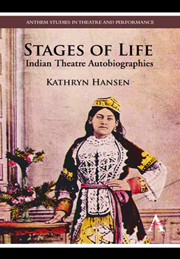Book contents
- Frontmatter
- Contents
- Illustrations
- Preface
- Acknowledgments
- PART 1
- 1 Pioneers to Professionals: A Retrospective of the Parsi Theatre
- 2 Theatrical Memoirs and the Archives of Autobiography
- PART 2
- PART 3
- Appendix 1 Historical Personages and Institutions
- Appendix 2 List of Plays and Films
- Glossary: Hindi and Urdu Terms
- Bibliography
- Index
2 - Theatrical Memoirs and the Archives of Autobiography
from PART 1
Published online by Cambridge University Press: 05 March 2012
- Frontmatter
- Contents
- Illustrations
- Preface
- Acknowledgments
- PART 1
- 1 Pioneers to Professionals: A Retrospective of the Parsi Theatre
- 2 Theatrical Memoirs and the Archives of Autobiography
- PART 2
- PART 3
- Appendix 1 Historical Personages and Institutions
- Appendix 2 List of Plays and Films
- Glossary: Hindi and Urdu Terms
- Bibliography
- Index
Summary
Autobiographical accounts by people in the theatrical profession began to appear in India in the early twentieth century. Binodini Dasi, the well-known actress from Calcutta, published Abhinetri Atmakatha (Autobiography of an Actress) in a magazine in 1910, and hers is likely the first of such writings. In the decades that followed, men and women of the Indian theatre—actors, actresses, playwrights, managers, and directors—recounted their lives in print for public consumption. Writing in Bengali, Hindi, Gujarati, Marathi, Tamil, and other languages of the professional stage, they created a unique type of autobiography and a distinct category of literature.
This chapter situates the four narratives in this volume within this newly created class of theatrical memoirs. To understand its evolution, I backtrack in the first section to consider the development of autobiography in India and debates about the definition of the genre. In the second section, I describe the emergence of theatrical reminiscences within print journalism and introduce several leading memoirs. Lastly, I characterize this class of texts as important to three historical archives: the archive of India's cultural formation in the nationalist era, the archive of dramatic practice and theatre as an institution, and the archive of oral performance and performers.
Autobiography in India
Autobiography as a separate literary genre came into being and acquired a following in a number of Indian languages in the second half of the nineteenth century.
- Type
- Chapter
- Information
- Stages of LifeIndian Theatre Autobiographies, pp. 26 - 48Publisher: Anthem PressPrint publication year: 2011



